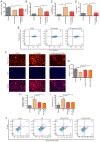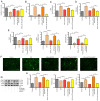Tanshinone IIA confers protection against myocardial ischemia/reperfusion injury by inhibiting ferroptosis and apoptosis via VDAC1
- PMID: 37800609
- PMCID: PMC10558218
- DOI: 10.3892/ijmm.2023.5312
Tanshinone IIA confers protection against myocardial ischemia/reperfusion injury by inhibiting ferroptosis and apoptosis via VDAC1
Abstract
Tanshinone IIA (TSN) extracted from danshen (Salvia miltiorrhiza) could protect cardiomyocytes against myocardial ischemia/reperfusion injury (IRI), however the underlying molecular mechanisms of action remain unclear. The aim of the present study was to identify the protective effects of TSN and its mechanisms of action through in vitro studies. An anoxia/reoxygenation (A/R) injury model was established using H9c2 cells to simulate myocardial IRI in vitro. Before A/R, H9c2 cardiomyoblasts were pretreated with 8 µM TSN or 10 µM ferrostatin‑1 (Fer‑1) or erastin. The cell counting kit 8 (CCK‑8) and lactate dehydrogenase (LDH) assay kit were used to detect the cell viability and cytotoxicity. The levels of total iron, glutathione (GSH), glutathione disulfide (GSSG), malondialdehyde (MDA), ferrous iron, caspase‑3 activity, and reactive oxygen species (ROS) were assessed using commercial kit. The levels of mitochondrial membrane potential (MMP), lipid ROS, cell apoptosis, and mitochondrial permeability transition pore (mPTP) opening were detected by flow cytometry. Transmission electron microscopy (TEM) was used to observed the mitochondrial damage. Protein levels were detected by western blot analysis. The interaction between TSN and voltage‑dependent anion channel 1 (VDAC1) was evaluated by molecular docking simulation. The results showed that pretreatment with TSN and Fer‑1 significantly decreased cell viability, glutathione peroxidase 4 (GPX4) protein and GSH expression and GSH/GSSG ratio and inhibited upregulation of LDH activity, prostaglandin endoperoxide synthase 2 and VDAC1 protein expression, ROS levels, mitochondrial injury and GSSG induced by A/R. TSN also effectively inhibited the damaging effects of erastin treatment. Additionally, TSN increased MMP and Bcl‑2/Bax ratio, while decreasing levels of apoptotic cells, activating Caspase‑3 and closing the mPTP. These effects were blocked by VDAC1 overexpression and the results of molecular docking simulation studies revealed a direct interaction between TSN and VDAC1. In conclusion, TSN pretreatment effectively attenuated H9c2 cardiomyocyte damage in an A/R injury model and VDAC1‑mediated ferroptosis and apoptosis served a vital role in the protective effects of TSN.
Keywords: apoptosis; ferroptosis; ischemia/reperfusion injury; tanshinone IIA; voltage- dependent anion channel 1.
Conflict of interest statement
The authors declare that they have no competing interests.
Figures








References
-
- Davidson SM, Ferdinandy P, Andreadou I, Bøtker HE, Heusch G, Ibáñez B, Ovize M, Schulz R, Yellon DM, Hausenloy DJ, et al. Multitarget strategies to reduce myocardial ischemia/reperfusion injury: JACC review topic of the week. J Am Coll Cardiol. 2019;73:89–99. doi: 10.1016/j.jacc.2018.09.086. - DOI - PubMed
-
- Lee JR, Park BW, Park JH, Lim S, Kwon SP, Hwang JW, Kim H, Park HJ, Kim BS. Local delivery of a senolytic drug in ischemia and reperfusion-injured heart attenuates cardiac remodeling and restores impaired cardiac function. Acta Biomater. 2021;135:520–533. doi: 10.1016/j.actbio.2021.08.028. - DOI - PubMed
-
- Gumpper-Fedus K, Park KH, Ma H, Zhou X, Bian Z, Krishnamurthy K, Sermersheim M, Zhou J, Tan T, Li L, et al. MG53 preserves mitochondrial integrity of cardiomyocytes during ischemia reperfusion-induced oxidative stress. Redox Biol. 2022;54:102357. doi: 10.1016/j.redox.2022.102357. - DOI - PMC - PubMed
MeSH terms
Substances
LinkOut - more resources
Full Text Sources
Research Materials

